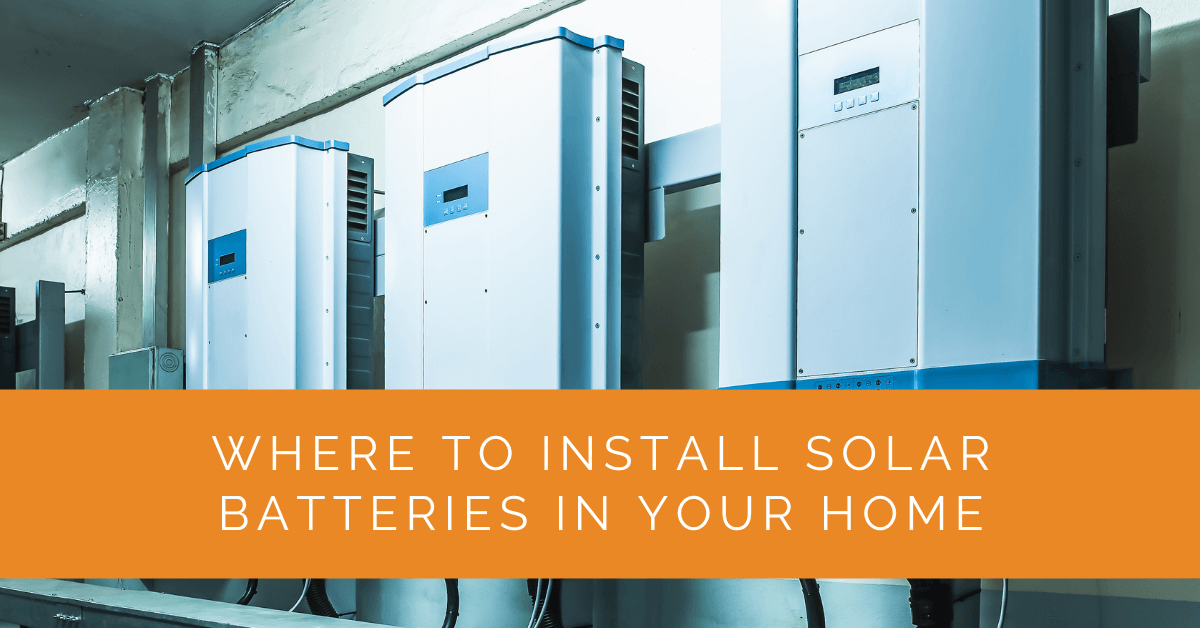With the increasing popularity of solar panel installations, many homeowners are now considering adding battery storage to their solar systems. Solar batteries play a crucial role in storing excess energy generated by solar panels, allowing you to utilize it when the sun isn’t shining. However, choosing the right location for your solar battery installation is essential for optimal performance and safety. In this article, we will guide you through the process of determining the ideal placement for your solar batteries in your home.
Contents
- 1 Key Takeaways
- 2 Understanding the Importance of Solar Batteries
- 3 Factors to Consider Before Installing Solar Batteries
- 4 Ideal Locations for Solar Battery Installation
- 5 Steps to Install Your Solar Batteries
- 6 Benefits of Installing Solar Batteries
- 7 Case Study: Optimal Placement for Solar Battery Installation in Residential Homes
- 8 Expert Insights From Our Solar Panel Installers About Where to Install Solar Batteries in Your Home
- 9 Experience Solar Excellence with Us!
- 10 Conclusion
- 11 FAQ
Key Takeaways
- Choosing the right location for solar battery installation is crucial for optimal performance and safety. Consider indoor options such as the garage or utility room, basement, or a dedicated battery room, as well as outdoor options like exterior wall mounting or ground-mounted enclosures.
- Before installing solar batteries, assess your solar panel system’s capacity, determine your battery storage needs based on energy consumption, and choose the right battery type, such as lithium-ion batteries.
- Engage a professional solar battery installer to ensure a seamless installation process, prepare your existing solar system for battery integration, select the optimal battery location, and correctly connect the batteries to your solar panel system. Enjoy the benefits of maximizing self-consumption, enhancing energy independence, and minimizing electricity costs through peak shaving.
Understanding the Importance of Solar Batteries
Solar batteries, also known as energy storage systems, store electricity generated by your solar panels for later use. They enable you to maximize the self-consumption of solar energy, reduce reliance on the grid, and enhance energy independence. By storing excess solar power, you can tap into it during cloudy days or at night when your solar panels aren’t producing electricity. This ensures a continuous and reliable power supply for your household.
Factors to Consider Before Installing Solar Batteries
Before jumping into the installation process, there are a few crucial factors to consider:
Assessing Your Solar Panel System
Evaluate the capacity and output of your existing solar panel system. Determine if it generates enough surplus electricity to make investing in a battery storage system worthwhile. Assessing your current system’s performance will help you identify the appropriate battery size and capacity to meet your energy storage requirements.
Determining Your Battery Storage Needs
Consider your household’s energy consumption patterns and electricity usage. Calculate the average amount of electricity you use daily and during peak hours. This analysis will help you determine the optimal storage capacity for your solar batteries. It’s important to balance meeting your energy needs and not overspending on battery capacity that exceeds your requirements.
Choosing the Right Battery Type
Selecting the right battery type is crucial for efficient energy storage. Lithium-ion batteries are popular due to their high energy density, longer lifespan, and faster charging capabilities. Consult a reputable solar installer to determine the most suitable battery technology. They can help you assess cost, performance, maintenance, and compatibility with your solar panel system.

Ideal Locations for Solar Battery Installation
When installing solar batteries, you have two primary options: indoor and outdoor locations. Let’s explore the benefits and considerations of each:
Indoor Locations for Solar Battery Installation
- Garage or Utility Room: These areas often offer sufficient space and protection from extreme temperatures. Ensure proper ventilation and adequate clearance around the battery system to prevent overheating. It’s important to consider the proximity of the battery storage to your solar inverter and electrical panel for ease of installation and maintenance.
- Basement: If your home has a basement, it can be an ideal location for housing your solar batteries. The cool and stable environment helps maintain optimal battery performance. However, ensure the basement is well-ventilated and free from excess moisture to prevent battery damage.
- Dedicated Battery Room: Creating a dedicated battery room can be a viable option if you have a larger battery storage system. This allows you to have centralized storage and better control over temperature and ventilation. Ensure proper insulation, ventilation, and adherence to local fire safety codes when designing a dedicated battery room.
Outdoor Locations for Solar Battery Installation
- Exterior Wall Mounting: Installing solar batteries on an exterior wall can save indoor space and simplify installation. However, consider weatherproofing measures and protection from direct sunlight or extreme weather conditions. Enclosures specifically designed for outdoor installation can provide additional protection against the elements.
- Ground-Mounted Enclosures: Ground-mounted enclosures provide flexibility regarding battery capacity and accessibility. Ensure the enclosure is adequately sealed and protected against environmental elements such as rain, snow, and UV radiation. Consider options with built-in security features to prevent theft or unauthorized access.
Safety Considerations for Battery Installation
Regardless of the chosen location, safety should always be a top priority. Here are a few safety considerations when installing solar batteries:
- Ensure proper ventilation and temperature control to prevent overheating. Consult the manufacturer’s guidelines for recommended ventilation requirements.
- Comply with local building codes and regulations for electrical installations. This ensures that the battery installation meets safety standards and reduces the risk of electrical hazards.
- Protect the battery system from potential physical damage or accidental contact. Use appropriate enclosures or barriers to prevent unauthorized access and safeguard against potential risks.
- Follow manufacturer guidelines for installation, maintenance, and emergency protocols. This includes properly connecting and grounding the battery system and understanding the correct procedures for handling emergencies or malfunctions.

Steps to Install Your Solar Batteries
Now that you have identified the ideal location for your solar batteries, it’s time to proceed with the installation process. Here’s a general outline of the steps involved:
Engaging a Professional Solar Battery Installer
Hire a reputable solar battery installer with experience designing and installing battery storage systems. They will assess your energy needs, recommend suitable equipment, and ensure a safe and efficient installation. A professional installer can also handle any necessary permits or paperwork required for the installation.
Preparing Your Existing Solar System for Battery Integration
Before installing the batteries, ensure your existing solar panel system is compatible with battery integration. Verify if your solar inverter supports energy storage and if any additional components or upgrades are necessary. Upgrading your solar inverter may be required to facilitate bidirectional energy flow between the solar panels, battery, and the grid.
Selecting the Optimal Battery Location
Choose the most suitable spot for your batteries based on the ideal location options. Ensure all necessary electrical connections and wiring are in place. Work with your solar battery installer to determine the most efficient routing of cables and optimize the distance between the battery storage, solar panels, and the inverter.
Connecting the Battery to Your Solar Panel System
Follow the manufacturer’s instructions and the guidance of your solar installer to connect the batteries to your solar panel system. This process involves integrating the battery system with the solar inverter and configuring the necessary settings. The installer will ensure the proper wiring and safety measures are in place, including proper grounding and overcurrent protection.
Benefits of Installing Solar Batteries
Integrating solar batteries into your home’s energy system offers numerous benefits:
Maximizing Self-Consumption of Solar Energy
You can maximize self-consumption by storing excess solar energy and utilizing it during periods of low or no solar production. This reduces reliance on the grid and allows you to save on electricity costs. With a solar battery system, you can increase your energy self-sufficiency and reduce the electricity you need to purchase from the utility.
Enhancing Energy Independence and Resilience
Solar batteries provide a reliable backup power source during grid outages, ensuring your essential appliances and systems continue to function. This enhances energy independence and provides peace of mind, particularly in areas prone to frequent power disruptions. A battery storage system allows you to maintain critical functions such as lighting, refrigeration, and communication, even when the grid is down.
Minimizing Electricity Costs through Peak Shaving
With a solar battery system, you can strategically use stored energy during peak demand periods when electricity rates are typically higher. This practice, known as peak shaving, helps minimize your overall electricity costs. By drawing power from the batteries instead of the grid during expensive peak hours, you can reduce your reliance on utility-provided electricity and potentially lower your electricity bills.
Case Study: Optimal Placement for Solar Battery Installation in Residential Homes
Background
At Solar Panels Network USA, we are dedicated to helping homeowners maximize the benefits of their solar energy systems by integrating battery storage. This case study highlights our approach to determining the optimal placement for solar batteries, ensuring safety, efficiency, and enhanced energy independence.
Project Overview
Our client, a suburban homeowner, sought to add battery storage to their existing solar panel system. The goal was to maximize self-consumption of solar energy, reduce reliance on the grid, and ensure a reliable backup power source during outages.
Implementation
Assessing Solar Panel System and Energy Needs
We began by evaluating the client’s current solar panel system, including its capacity and energy output. We also analyzed the household’s energy consumption patterns to determine the appropriate battery size and capacity required to meet their storage needs.
Choosing the Right Battery Type
Based on the client’s requirements, we recommended lithium-ion batteries due to their high energy density, longer lifespan, and faster charging capabilities. This choice ensured efficient energy storage and optimal performance.
Identifying Ideal Battery Locations
We considered both indoor and outdoor locations for battery installation, weighing factors such as space availability, temperature control, and accessibility:
- Garage or Utility Room: These areas provided ample space and protection from extreme temperatures. Proper ventilation was ensured to prevent overheating, and the proximity to the solar inverter and electrical panel facilitated easy installation and maintenance.
- Basement: The cool and stable environment of the basement was ideal for maintaining battery performance. We ensured the area was well-ventilated and free from excess moisture to prevent battery damage.
- Exterior Wall Mounting: This option saved indoor space and simplified installation. Weatherproofing measures were implemented to protect the batteries from direct sunlight and extreme weather conditions.
- Ground-Mounted Enclosures: These provided flexibility regarding battery capacity and accessibility. The enclosures were adequately sealed and protected against environmental elements such as rain, snow, and UV radiation.
Safety Considerations
Safety was a top priority throughout the installation process. We ensured proper ventilation and temperature control, complied with local building codes and regulations, and protected the battery system from potential physical damage or accidental contact. The manufacturer’s guidelines for installation, maintenance, and emergency protocols were strictly followed.
Results
The strategic placement of solar batteries provided the client with several significant benefits:
- Maximized Self-Consumption: By storing excess solar energy, the client maximized self-consumption, reducing reliance on the grid and saving on electricity costs.
- Enhanced Energy Independence: The battery system provided a reliable backup power source during grid outages, ensuring essential appliances and systems continued to function.
- Improved System Efficiency: Proper placement and integration of the batteries optimized energy storage and system performance.
- Cost Savings: Reduced reliance on grid electricity and peak shaving practices minimized electricity costs.
Summary
At Solar Panels Network USA, our expertise in solar battery installation ensures that our clients enjoy the full benefits of their solar energy systems. By carefully assessing energy needs, choosing the right battery type, and determining the ideal placement for solar batteries, we help homeowners achieve greater energy independence, reduce electricity costs, and enhance system efficiency. Our commitment to quality and innovation drives us to provide solutions that contribute to a sustainable and energy-efficient future.
Expert Insights From Our Solar Panel Installers About Where to Install Solar Batteries in Your Home
Proper placement of solar batteries is critical to ensuring optimal performance and longevity. Indoor locations like a garage or utility room provide a controlled environment, minimizing exposure to extreme temperatures.
Senior Solar Engineer
Outdoor installations, such as ground-mounted enclosures, offer flexibility in battery capacity and ease of access. However, it’s essential to ensure adequate weatherproofing and security measures.
Solar Installation Specialist
Engaging a professional installer is key to a seamless and safe battery installation process. They ensure correct integration with existing solar systems and adherence to local safety regulations.
Lead Solar Technician
Experience Solar Excellence with Us!
Trust in Solar Panels Network USA, where our seasoned experts deliver top-quality solar solutions for homes and businesses nationwide. With a legacy of countless successful installations and a commitment to sustainable energy, we’re your reliable partner in the solar journey. Ready for a brighter, eco-friendly future? Call us now at (855) 427-0058 and harness the power of the sun!
Conclusion
Properly installing solar batteries is essential for maximizing the benefits of your solar panel system. Considering your energy needs, battery type, and ideal locations, you can ensure optimal performance and safety. Engaging a professional solar installer is highly recommended to guarantee a seamless installation process. With solar batteries, you can enjoy greater energy independence, reduced electricity costs, and a more resilient energy system for your home.
Remember, solar battery installation involves electrical components and potentially hazardous tasks. Always prioritize safety and consult with experts in the field to make informed decisions. A professional solar installer can guide you through the process, from assessing your needs to choosing the right equipment and ensuring a safe and efficient installation. Enjoy the benefits of solar batteries and take a step towards a greener and more sustainable energy future for your home.
FAQ
Where is the best place to put solar batteries?
The best place to put solar batteries depends on various factors such as available space, temperature control, and accessibility. Indoor locations like the garage, utility room, or basement are popular, while outdoor options include exterior wall mounting or ground-mounted enclosures. Consider factors like ventilation, protection from extreme temperatures, and adherence to local safety regulations when determining the ideal location.
How far can a solar battery be from the house?
The distance between a solar battery and the house is not typically a limiting factor. As long as the battery is properly connected to the solar panel system and the inverter, it can be located reasonably far from the house. However, it’s important to ensure proper electrical connections and wiring to maintain optimal performance and safety.
How close can an inverter be to a battery?
The distance between an inverter and a battery depends on the specific requirements and guidelines provided by the equipment manufacturer. It’s recommended to follow the manufacturer’s instructions for installation, which may include guidelines for the appropriate distance between the inverter and the battery. Proper electrical connections, grounding, and adherence to safety regulations are essential considerations when positioning the inverter around the battery.
About the Author
Solar Panels Network USA stands at the forefront of solar energy solutions, driven by a team of seasoned solar engineers and energy consultants. With over decades of experience in delivering high-quality solar installations and maintenance, we are committed to promoting sustainable energy through customer-centric, tailored solutions. Our articles reflect this commitment, crafted collaboratively by experts to provide accurate, up-to-date insights into solar technology, ensuring our readers are well-informed and empowered in their solar energy decisions.

